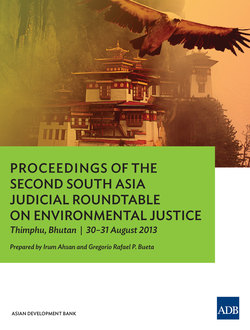Читать книгу Proceedings of the Second South Asia Judicial Roundtable on Environmental Justice - Irum Ahsan - Страница 4
На сайте Литреса книга снята с продажи.
FOREWORD
ОглавлениеEnvironmental justice has been brought to the fore by many judiciaries in the Asia and the Pacific region, especially those of the South Asian Association for Regional Cooperation (SAARC) and Association of Southeast Asian Nations (ASEAN) member countries. In support, the Asian Development Bank (ADB) has taken the lead in starting the dialogue and fostering regional cooperation and collaboration on environmental law in the region. ADB has emphasized its strategic commitment to environmental sustainability, combating climate change, and good environmental governance through various strategic documents, including Strategy 2020, its Governance Policy, and Safeguard Policy Statement.
Toward this goal, the Asian Judges Symposium on Environmental Decision Making, the Rule of Law, and Environmental Governance was held at ADB headquarters, Manila, Philippines, in July 2010. Around 120 senior judges, environment ministry officials, members of civil society, and experts in environmental law discussed ways to promote the protection of the environment through effective environmental adjudication and law enforcement. Under the auspices of this Asia-wide symposium, the chief justices of Indonesia (for ASEAN) and Pakistan (for SAARC) endeavored to create concrete subregional action plans on how judiciaries can cooperate to address common environmental challenges. For the SAARC region, the First South Asia Judicial Roundtable on Environmental Justice was held in Pakistan in March 2012, followed by the Second South Asia Judicial Roundtable on Environmental Justice in Bhutan in August 2013.
On 31 August 2013, this Second South Asia Judicial Roundtable on Environmental Justice resulted in the Thimphu Declaration, which recognizes critical environmental challenges confronting the region as well as the important, unique role of the judiciary in ensuring environmental protection by upholding environmental rights and providing fair and consistent adjudication of issues in environmental cases. Participants also agreed to enhance collaborative efforts among judiciaries in the region through a draft memorandum of understanding for cooperation among South Asian judiciaries, focusing on knowledge-sharing among judiciaries, capacity building, and strengthening the judiciaries’ focus on environmental issues.
Three key messages emerged from this roundtable. First, we were made more aware of the pressing environmental challenges that threaten sustainable growth in South Asia. The region continues to experience intense and extreme weather events, putting great stress on the region’s water supply and subsistence systems, as well as endangering human safety, livelihoods and economies. Ecosystems and wildlife are threatened, while deforestation continues to degrade the region’s once lush forest resources. Further, air and water pollution and mismanagement of waste are negatively impacting human health. These dangers threaten not only current and future sustainable economic development, but jeopardize progress already achieved through investment of human and resource capital in so many areas.
Second, we identified key challenges that South Asian judiciaries face in resolving environmental disputes. Existing legislation does not comprehensively capture environmental impacts, limiting the extent to which the judiciary and the environmental enforcement chain can address these environmental issues. Other limitations in legal systems were noted, such as access to environmental justice, adequate court remedies to address violations of environmental rights, as well as capacity constraints faced by judges and justices in the region.
Third, concrete judicial cooperation and knowledge-sharing on matters of environmental adjudication in the region is crucial. The sharing of knowledge and best practices is vital for judiciaries, because it enables each judiciary to learn and explore ways to strengthen environmental adjudication in their respective countries. Thus, this judicial network on the environment is key to attaining a unified approach for better environmental enforcement in the region.
This roundtable was a very encouraging step toward greater collaboration and coordination; the participants’ commitment to the event is a significant milestone in itself. It gave judges an opportunity to share best practices, discuss developing case law, and find ways toward a common understanding of environmental justice in the region. It also provided South Asian judiciaries the opportunity to work concretely on identifying common challenges and specific cooperative measures to address them. Countries now have an important opportunity to fulfill the real potential that was agreed upon at the First South Asia Judicial Roundtable through the Bhurban Declaration.
This report records the proceedings of the second roundtable. It is our wish that readers will find this publication helpful in understanding the continuing development of the concept of environmental justice in South Asia. The need to protect South Asia’s environment is unquestionable, as is the need to build the capacity of the judiciary in addressing these challenges.
Christopher H. Stephens
General Counsel
Office of the General Counsel
Asian Development Bank
January 2015
